英语词汇学课件Chapter 2
- 格式:doc
- 大小:97.00 KB
- 文档页数:12
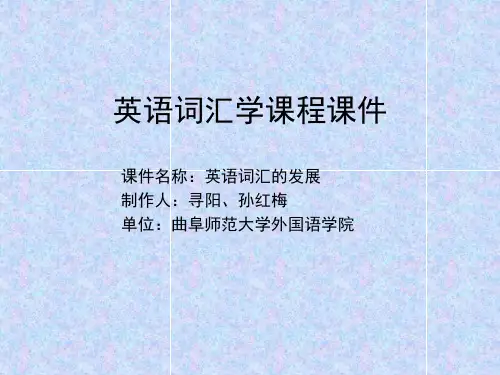
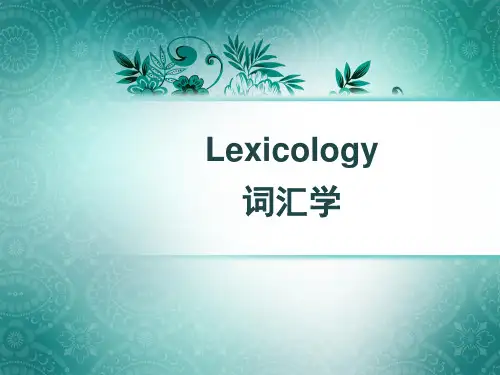
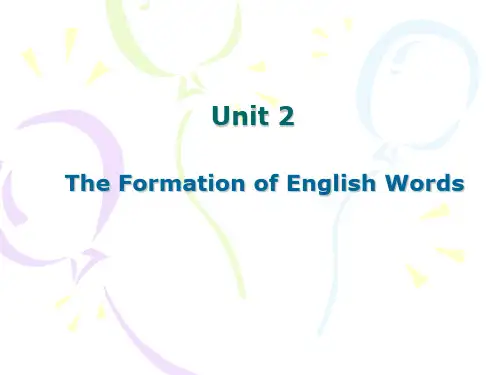
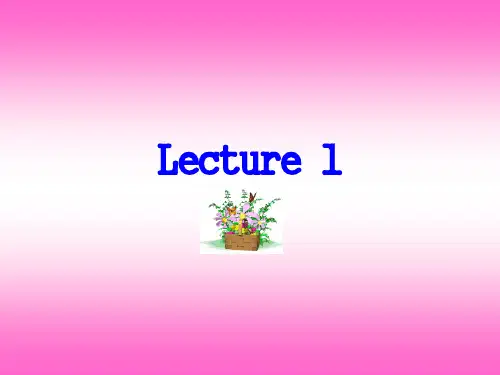
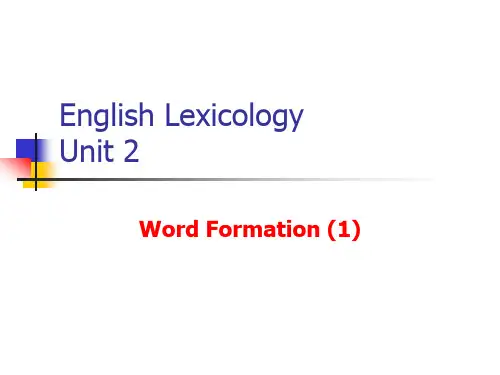

CHAPTER 21. It is assumed that the world has about ___________ languages.A. 3000B. 2000C. 1000D.40002. It is assumed that the world has approximately 3000 (some put it 5000) languages, which can be grouped into roughly ___________ language families on the basis of similarities in their basic word stock and grammar.A. 500B. 4000C. 300D.20003. The Indo-European Language Family accordingly fall into ___________ principle groups, which can be grouped into an Eastern set and Western set.A. eightB. sixC. fiveD. several4. In the Eastern set, ___________ and ___________ are each the only modern language respectively.A. Italic; GermanicB. Armenian; AlbanianC. Celtic; HellenicD. Balto-Slavic; Indo-Iranian5. The following words are derived from the dead language Sanskrit except ___________.A. PersianB. BengaliC. HindiD. Romany6. All these languages have some influence on English to a greater or lesser extent because each has ___________ the English vocabulary.A. borrowed words fromB. enlarged words toC. decreased words toD. lent words into7. We find the following languages in the Celtic except ___________.A. ScottishB. IrishC. DanishD. Breton8. The Balto-Slavic comprises such modern languages as Prussian, Lithuanian, Polish, Czech, Bulgarian, Slovenian and ___________.A. GreekB. RomanC. IndianD. Russian9. Indo-Iranian comprises the modern language except ___________.A. PersianB. BengaliC. Hindi, RomanyD. Polish10. The five Romance languages, namely, Portuguese, Spanish, French, Italian, Romanian all belong to the Italic through an intermediate language called ___________.A. SanskritB. LatinC. CelticD. Anglo-Saxon11. The first peoples known to inhabit England were ___________.A. CeltsB. RomansC. Anglo-SaxonsD. Jutes12. Which of the following is not included in the Germanic tribes?A. Angles.B. Celtic.C. Saxons.D. Jutes.13. Some foreign languages have impact on old English except ___________.A. FrenchB. LatinC. NorwegianD. Danish14. After the ___________, the Germanic tribes called Angles, Saxons, and Jutes came in great numbers.A. GreeksB. IndiansC. RomansD. French15. As a result, Celtic made only a ___________ contribution to the English vocabulary.A. smallB. bigC. greatD. smaller16. The introduction of ___________ at the end of the 6th century had a great impact on the English vocabulary.A. printingB. ChristianityC. French wordsD. all the above17. After the invading Germanic tribes settled down in Britain, their language almost totally blotted out the ___________.A. Old EnglishB. Middle EnglishC. Anglo-SaxonD. Celtic18. Old English has a vocabulary of about ___________ words.A. 30000 to 40000B. 40000 to 50000C. 50000 to 60000D. 60000 to 7000019. It is estimated that at least ___________ words of Scandinavian origin have survived in modern English.A. 1200B. 800C. 900D. 100020. Which of the following is not Scandinavian origin?A. Skirt.B. Alter.C. Their.D. Birth.21. The ___________ family consists of the four Northern European Languages: Norwegian, Icelandic, Danish and Swedish, which are generally known as Scandinavian languages.A. GermanicB. Indo-EuropeanC. AlbanianD. Hellenic22. Old English vocabulary was essentially ___________ with a number of borrowings from Latin and Scandinavian.A. ItalicB. GermanicC. CelticD. Hellenic23. The Norman Conquest in 1066 introduced a large number of words into the English vocabulary.A. FrenchB. GreekC. DanishD. Latin24. In the 9th century the land was invaded again by Norwegian and Danish Vikings. With the invaders, many ___________ words came into the English language.A. GreekB. RomanC. CelticD. Scandinavian25. Which of the following is NOT true about Old English?A. Users of Old English borrowed heavily from Latin and other languages.B. Old English has a vocabulary of about 50000 to 60000.C. Old English refers to the English language used from 450 to 1150.D. Old English was a highly inflected language.26. Identify the word that ___________ is of Scandinavian origin among the following.A. skirtB. dressC. modelD. status27. The Norman Conquest started a continual flow of French words into English ___________ of them are still in use today.A. Eighty-five percentB. Fifty-six percentC. Seventy-two percentD. Seventy-five percent28. By the end of the ___________ century, virtually all of the people who held political or social power and many of those in powerful Church positions were of Norman French origin.A. 10thB. 11thC. 12thD. 13th29. Modern English began with the establishment of ___________ in England.A. printingB. Bourgeois RevolutionC. Industrial RevolutionD. the Renaissance30. Considering the changes in ___________, we regard the year of ___________ as the divison line of Early and Late Modern English.A. grammar; 1600B. grammar; 1700C. vocabulary; 1600D. vocabulary; 170031. Since the beginning of the 20th century, ___________ has become even more important for the expansion of English vocabulary.A. word-formationB. borrowingC. semantic changeD. both B and C32. Which of the following is NOT one of the main sources of new words?A. The rapid development of modern science and technology.B. Geographical and political changes.C. The influence of other cultures and languages.D. Social and economic changes.33. Social, economic and political changes bring about such new words as the followings EXCEPT ___________.A. kungfuB. TV dinnerC. fast foodD. Watergate34. The modes of modern English vocabulary grow through three major channels: ___________, semantic change, ___________.A. exchange; lendingB. derivation; borrowingC. creation; borrowingD. affixation; creation35. In modern times, ___________ is the most important way of vocabulary expansion.A. creationB. semantic changeC. borrowingD. reviving archaic or obsolete words36. ___________ has played a vital role in the development of vocabulary, particularly in earlier times.A. creationB. semantic changeC. borrowingD. obsolete words37. Which of the following is one of the three channels through which modern English vocabularydevelops?A. Acronym.B. Blending.C. Elevation.D. Borrowing.38. ___________ means an old form which takes on a new meaning to meet the new need.A. CreationB. Semantic changeC. BorrowingD. Derivation39. The word of "recollection" is formed by ___________.A. creationB. semantic changeC. borrowingD. collocation40. It is assumed that the world has 3 000 languages, which can be grouped into roughly ___________ language families on the basis of similarities in their basic word stock and grammar. A. 200 B. 300C. 400D. 50041. The following languages all belong to the Eastern set except___________.A. Balto-SlavicB. Indo-IranianC. ArmenianD. Italic42. In the Eastern set, Armenian and___________ are the sole modern languages in two respective families.A. AlbanianB. RussianC. SlovenianD. Lithuanian43. Which language does not belong to the Italic?A. Portuguese.B. Spanish.C. Welsh.D. French.44. The early inhabitants of the British Isles spoke___________.A. EnglishB. CelticC. ScandinavianD. Hellenic45. The Germanic speakers took permanent control of the land that was later called___________ (the land of Angles).A. GermanB. GreeceC. EnglandD. American46. Old English has a vocabulary of about 50 000 to 60 000words, which is entirely Germanic with only a few borrowings from___________ and Scandinavian.A. LatinB. GreekC. CelticD. French47. The influx of French words into English did not occur until after___________.A. 1200B. 1300C. 1400D. 150048. In the Middle English period, the three main dialects of the land were Northern, ___________ and Midland.A. EasternB. WesternC. SouthernD. Oriental49. ___________ is the chief ancestor of Modern English, not Southern.A. EasternB. WesternC. NorthernD. Midland50. The Norman Conquest started a continual flow of___________ words into English.A. LatinB. GreekC. DanishD. French51. Midland is an ___________ dialect, as its name implies, and intelligible to Northerners and Southerners alike.A. middleB. intermediateC. interchangeableD. internal52. The number of ___________ words that poured into English was unbelievably great and covered every realm of culture and society in the Middle English period.A. FrenchB. GermanC. LatinD. Russian53. Before English regained social status in Middle English period, those in power spoke French; those who were literate read and wrote ___________; those who could educate their children taught them in ___________; and any young man who sought to earn his living as a scribe learned ___________or ___________.A. Latin; French; Latin; FrenchB. French; French; French; EnglishC. French; French; Latin; FrenchD. Greek; French; Greek; French54. In the early period of Modern English, Europe saw a new upsurge in learning ancient Greek and Roman classics, which is known in history as the ___________.A. RenewalB. RevivalC. ReboundD. Renaissance55. Since the beginning of the 20th century, particularly after World War II, although borrowing remains a channel of English vocabulary expansion, more words are created by ___________.A. analogyB. word-formationC. transferD. conversion56. The Anglo-Saxon in the Old English period was almost a "___________" language, which created new words from its own compound elements with few foreign words.A. uniqueB. fashionC. pureD. old57. As one scholar notes, old English was characterized by " ___________ endings", Middle English by "leveled endings", and Modern English by " ___________ endings".A. full; lostB. lost; fullC. full; pureD. pure; lost58. Old English which was a ___________ language has evolved to the present language.A. analytic; syntheticB. synthetic; analyticC. agglutinative; analyticD. isolating; synthetic59. Of all the foreign languages from which we have borrowed words, Latin, Greek, French, and ___________ stand out as the major contributors.A. ItalianB. GermanC. DutchD. Scandinavian60. In the Pre-Anglo-Saxon period, the words borrowed naturally from Latin reflected the new conceptions and experience in ___________ and ___________.A. war; economyB. economy; agricultureC. war; place namesD. war; agriculture61. In the Old English period, borrowings from Latin came in because of the introduction of Christianity, such as, ___________ and ___________.A. cook; candleB. shrine; sackC. candle; shrineD. mass; circle62. The ___________ centuries were especially prolific in Latin borrowings under the influence of Renaissance.A. 12th and 13thB. 13th and 14thC. 14th and 15thD. 15th and 16th63. Some late borrowings from Latin still retain their Latin forms. Which of the following was borrowed in the Modern English period?A. Frustrate.B. Focus.C. Logic.D. Trade.64. Which of the following does not come from Greek?A. Piano.B. Synonym.C. Philosophy.D. Lexicology.65. Typhoon is from ___________ and tatami is from ___________.A. Chinese; AfricanB. Chinese; JapaneseC. Arabic; TurkishD. Malay; Japanese66. Modern English vocabulary develops through ___________.A. terminology, analogy and borrowingB. creation* semantic change and borrowingC. creation, archaisms and semantic changeD. semantic change, denizens and argot67. Which of the following contemporary English vocabulary is from the rapid growth of science and technology?A. Fallout.B. Pant suit.C. Black belt.D. Mao jackets.68. The Scandinavian languages: Norwegian* Swedish, Danish and Icelandic, constitute the ___________ branch of the Germanic group.A. easternB. westernC. northernD. southern69. Reviving archaic or ___________ words also contributes to the growth of English vocabulary though insignificant.A. obsoleteB. oldC. usedD. ancient70. It is assumed that the world has about ___________ languages.A. 3,000B. 2,000C. 1,000D. 4,00071. All languages can be grouped into roughly ___________ language families on the basis of similarities in their basic word stock and grammar.A. 200B. 300C. 400D. 50072. The Indo-European language family is made up of most of the languages in the following places except ___________.A. EuropeB. the Near EastC. IndiaD. Africa73. The prehistoric Indo-European parent language is thought to be a highly ___________ language.A. developedB. advancedC. inflectedD. complicated74. In the western set of the Indo-European language family, Greek is the modern language derived from ___________.A. HellenicB. CelticC. SpanishD. Dutch75. We find the following languages in the Celtic except ___________.A. ScottishB. IrishC. DanishD. Breton76. The first peoples known to inhabit on British Isles were ___________.A. RomansB. GermansC. CeltsD. Saxons77. Now people generally refer to ___________ as old English.A. Anglo-SaxonB. CelticC. LatinD. Armenian78. Which of the following is not included in the Germanic tribes?A. AnglesB. CelticC. SaxonsD. Jutes79. Old English has a vocabulary of about ___________ words.A. 40,000 to 50,000B. 50,000 to 60,000C. 60,000 to 70,000D. 30,000 to 40,00080. Old English refers to the language used between ___________ and ___________.A. 410, 1150B.450, 1150C. 410, 1100D.450, 110081. Some foreign languages have impact on old English except ___________.A. FrenchB. LatinC. NorwegianD. Danish82. It is estimated that at least ___________ words of Scandinavian origin have survived in Modern English.A. 1,200B. 800C. 900D. 1,00083. Which of the following is not Scandinavian origin?A. skirtB. alterC. theirD. birth84. Until 1066, the influence on English was mainly ___________.A. LatinB. FrenchC. GermanicD. Celtic85. After the Norman Conquest a continual flow of ___________ words into English.A. LatinB. FrenchC. GermanicD. Celtic86. Between 1250 and 1500, about ___________ words of French origin poured into English.A. 7,000B. 6,000C. 9,000D. 10,00087. ___________ of the words of French origin are still in use today.A. Eighty-five percentB. Fifty-six percentC. Seventy-two percentD. Seventy-five percent88. As many as 2, 500 words of ___________ origin found their way into Middle English.A. DutchB. FrenchC. LatinD. Celtic89. Modern English began with the establishment of ___________ in England.A. printingB. Bourgeois RevolutionC. Industrial RevolutionD. Renaissance Time90. Modern English began in ___________.A. 1700B. 1066C. 1500D. 190091. Considering the changes in ___________ Early and Late Modem English.A. grammar, 1600B. grammar, 1700C. vocabulary, 1600D. vocabulary, 170092. Modern English is considered to be a/an ___________ language.A. inflectedB. analyticC. syntheticD. new93. Generally, the number of the present day English vocabulary is about ___________.A. two millionB. three millionC. one millionD. four million94. Modern English vocabulary develops through ___________.A. creationB. semantic changeC. borrowingD. all the above95. ___________ is not the reason of growth of present-day English vocabulary.A. The rapid development of modern science and technologyB. Social, economic and political changesC. The efforts of linguistsD. The influence of other cultures and languages96. Modern English vocabulary develops through three channels: ___________, semantic change and ___________.A. exchange, conversionB. compounding, borrowingC. creation, borrowingD. suffixation, creation97. ___________ is the most important way of vocabulary expansion.A. CreationB. Semantic changeC. BorrowingD. Meaning change98. ___________ means an old form which takes on a new meaning to meet the new need.A. CreationB. Semantic changeC. BorrowingD. Derivation99. The word of "recollection" is formed by ___________.A. creationB. semantic changeC. borrowingD. collocation100. Modern English vocabulary develops through three channels: ___________.A. creation, conversion and borrowingB. creation, borrowing and back-formationC. creation, semantic change and borrowingD. semantic change, borrowing and back-formation101. The Norman Conquest in 1066 introduced a large number of ___________ words into the English vocabulary.A. FrenchB. GreekC. DanishD. Latin102. The introduction of ___________ had a great impact on the English vocabulary.A. HinduismB. ChristianityC. BuddhismD. Islam103. After the ___________, the Germanic tribes called Angles, Saxons, and Jutes came in great numbers.A. GreeksB. IndiansC. RomansD. French104. After the invading Germanic tribes settled down in Britain, their language almost totally blotted out the ___________.A. Old EnglishB. Middle EnglishC. Anglo-SaxonD. Celtic105. Between 1250 and 1500 about ___________ words of French origin poured into English.A. 9,000B. 900C. 10,000D. 20,000106. Since the beginning of the 20th century, ___________ has become even more important for the expansion of English vocabulary.A. word-formationB. creationC. semantic changeD. both B and C107. The prehistoric Indo-European parent language is thought to be a highly language.A. inflectedB. derivedC. developedD. analyzed108. The five Romance languages, namely, Portuguese, Spanish, French, Italian, Romanian all belong to the Italic through an intermediate language called ___________.A. SanskritB. LatinC. CelticD. Anglo-Saxon109. By the end of the ___________ century, English gradually came back into the schools, the law courts, and government and regained social status.A. 12thB. 13thC. 14thD. 15th1. The prehistoric Indo-European parent language is thought to be a highly ___________ language.2. As the invading tribes took over and settled in Britain, the Celtic languages gradually ___________.3. The surviving languages show various degrees of ___________ to one another.4. The surviving languages accordingly fall into eight principal groups, which can be grouped into an Eastern set: Balto-Slavic, Indo-Iranian, Armenian and Albanian; a Western set: Celtic, Italic, Hellenic, ___________.5. Scandinavian language refers to Icelandic, Norwegian, Danish and ___________.6. After the Romans, the Germanic tribes came in great numbers. Soon they took___________ control of the land, which was to be called England.7. Augustine came to spread ___________ in Britain at the end of the 6th century.8. Now people generally refer to Anglo-Saxon as ___________.9. In the 9th century the land was ___________ again by Norwegian and Danish Vikings.10. Middle English lasted for more than three hundred years from ___________ to ___________.11. The four major foreign contributors to English vocabulary in earlier times are Latin, French, Scandinavian and ___________.12. By the end of the eleventh century, ___________ all of the people who held political or social power and many of those in powerful church positions were of Norman French origin.13. The English words "power", "crime" are derived from ___________.14. Modern English began with the ___________ of printing in England.15. In the early period of Modern English, Europe saw a new upsurge of learning ancient and Roman classics. This is known in history as the ___________.16. It is necessary to subdivide Modern English into Early (1500 -1700) and ___________ Modem English.17. If we say that Old English was a language of full endings, Middle English was one of ___________.18. It can be concluded that English has evoked from a synthetic language (Old English) to the present ___________ language.19. The rapid development of ___________ and ___________ contributes a lot to the vocabulary development.20. ___________ refers to the formation of new words by using the existing materials, namely roots, ___________ and other elements.21. There're three modes of vocabulary development; creation, ___________ and borrowing.22. World languages can be grouped into roughly ___________ language families on the basis of similarities in the basic word stock and grammar.23. The surviving languages accordingly fall into ___________ principal groups, which can be grouped into an Eastern set and a Western set.24. Scandinavian language refers to Icelandic, Norwegian, Danish and ___________.25. Old English was the combination of three ___________ dialects which were used between ___________ and 1150.26. Old English was a highly ___________ language just like modern German.27. Old English has a vocabulary of about ___________ to ___________ words.28. Middle English lasted for more than three hundred years from ___________ to ___________.29. The four major foreign contributors to English vocabulary in earlier times are Latin, French, Scandinavian and ___________.30. The English words "power”, "crime" are derived from ___________.31. The introduction of ___________ into England marked the beginning of modem English period.32. Modern English began with the establishment of printing in England, and it can be subdivided into stages.33. Modern English is a ___________ language.34. The rapid development of ___________ and ___________ contributes a lot to the vocabulary development.35. ___________ refers to the formation of new words by using the existing materials, namely roots, ___________ and other elements.36. There’re three modes of vocabulary development: creation, ___________ and borrowing.37. It is necessary to subdivide Modern English into Early (1500 - 1700) and ___________ Modern English.38. The language used in England between 450 and 1150 is called ___________.39. If we say that Old English was a language of full endings, Middle English was one of ___________.40. The surviving languages accordingly fall into eight principal groups, which can be grouped into an Eastern set: Balto-Slavic, Indo-Iranian, Armenian and Albanian; a Western set: Celtic, Italic, Hellenic, ___________.41. It can be concluded that English has evolved from a synthetic language (Old English) to the present ___________ language.42. Now people generally refer to ___________ as Old English.43. The language used between 450 and ___________ is called ___________, which has a vocabulary of ___________. Middle English refers to the language spoken from 1150 to ___________. Followed by the ___________ period, subdivided as early modern English (___________) and late ___________ (1700-up to now).( ) 1. English is more closely related to German than French.( ) 2. Scandinavian languages refer to Icelandic, Norwegian, Danish and Swedish.( ) 3. Old English was a highly inflected language.( ) 4. In early Middle English period, English, Latin and Celtic existed side by side.( ) 5.The introduction of printing into England marked the beginning of Modern English period. ( ) 6. Modern English is considered to be an analytic language.( ) 7. The four major foreign contributors to English vocabulary in earlier times are Latin, French, Scandinavian and Italian.( ) 8. In modern times, borrowing brings less than ten percent of modern English vocabulary. ( ) 9. The three major factors that promote the growth of modern English vocabulary are advances in science and technology* influence of foreign cultures and languages.( ) 10. The most important mode of vocabulary development in present-day English is creation of new words by means of word-formation.( ) 11. Old English vocabulary was in essence Germanic with a small quantity of words borrowed from Latin and Scandinavian.( ) 12. Middle English absorbed a tremendous number of foreign words but with little change in word endings.( ) 13. Old English refers to the language used between 100 and 450.( ) 14. We refer to Celtic as old English.( ) 15. Words of old English had full endings.( ) 16. In 55 B. C. -54 B. C., the Romans invaded the British Isles and were to occupy the land until about 410.( ) 17. Celtic made only a small contribution to the English vocabulary.( ) 18. Many religious terms such as abbot, candle, alter, amen were brought into English by Latin-speaking Roman missionaries.( ) 19. Middle English lasted for more than four hundred years.( ) 20. During the Middle English period, Celtic, Latin and English existed side by side.( ) 21. During early Middle English period, Norman French became the polite speech while native tongue was a despised language.( ) 22. Middle English was a language of full endings.( ) 23. Modern English is a synthetic language.( ) 24. After World War II, thousands of new words have been created to express new ideas, inventions and scientific achievements.( ) 25. The influence of other cultures and languages is one of the main sources of new words. ( ) 26. Semantic change is the most important way of vocabulary expansion.( ) 27. In the vocabulary development, some old words fell out of use.( ) 28. The introduction of printing into England by William Caxton marked the beginning of Middle English period.( ) 29. Historically speaking, American English is older than British English.( ) 30. The Norman Conquest virtually introduced French-English bilingualism into Britain. ( ) 31. The late Modern English period is characterized by the complete loss of endings.1.What are the main sources of new words?2. What are the features of Old English, Middle English and Modern English? What changes has English undergone as far as inflection is concerned?3. What are the reasons for the growth of contemporary English vocabulary?。
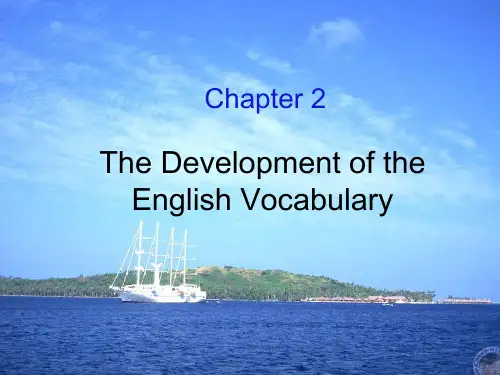
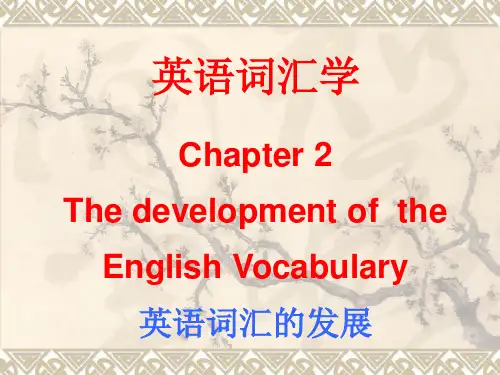

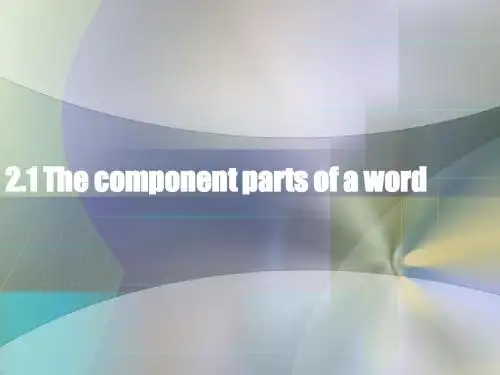
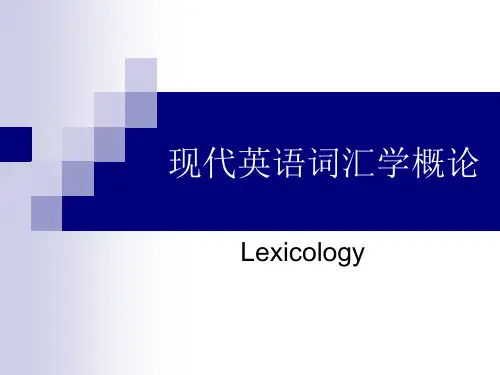
Lectures on English LexicologyMain Sections for the Lectures:Chapter 1: Basic Concepts of Words and Vocabulary1.1What Is a Word?A word is a minimal free form of a language that has a given sound and meaning and syntactic function.1.2 Sound and MeaningA word is a symbol that stands for something else in the world. This symbolic connection is almost always arbitrary, and there is no logical relationship between the sound which stands for a thing or an idea and the actual thing and idea itself. The relationship between sound and meaning is conventional because people of the same speech community have agreed to refer to a certain thing with a cluster of sounds. In different languages the same concept can be represented by different sounds.1.3 Sound and FormIt is generally agreed that the written form of a natural language is the written record of the oral form. The English alphabet was adopted from the Romans.In spite of the differences, at least eighty percent of the English words fit consistent spelling patterns.1.4 V ocabularyAll the words in a language make up its vocabulary.The general estimate of the present-day English vocabulary is over one million words.1.5 Classification of Words1.5.1 Basic Word Stock and Non-basic V ocabularyBasic words have the following characteristics:1.All national character: they denote the most common things and phenomena ofthe world around us, which are indispensable to all the people who speak the language.2.Stability: as these words denote the commonest things necessary to life, they arelikely to remain unchanged.3.Productivity:as they are mostly root words or monosyllabic words, they caneach be used alone, and at the same time can form new words with other roots and affixes4.Polysemy:words of this kind often possess more than one meaning becausemost of them have undergone semantic changes in the course of use and become polysemous.5.Collocability: most of these words enter quite a number of set expressions,idiomatic usages, and proverbial sayings.“All national character” is the most important of all features that may differentiate words of common use from all others.Non-basic words include the following:1.Terminology(术语): technical terms used in particular disciplines andacademic areas.2.Jargon(行话): the specialized vocabularies by which members of particular arts,sciences, trades and professions communicate among themselves.3.Slang(俚语)4.Argot(黑话)5.Dialectal words(方言词语)6.Archaisms(古语)7.Neologisms(新词)1.5.2 Content Words and Functional WordsContent words denote clear notions and thus are known as notional words(实义词). They include nouns, verbs, adjectives, adverbs and numerals, which denote objects, phenomena, action, quality, state, degree, quantity, etc.Functional words do not have notions of their own. They are also called empty words. The chief function of these words is to express the relation between notions, the relation between words as well as between sentences. They are known as form words. Prepositions, conjunctions, auxiliaries and articles belong to this category.Content words are numerous and the number is ever growing whereas the functional words which make up a small number of vocabulary,remain stable. However, functional words do far more work of expression in English on average than content words.1.5.3 Native Words and Borrowed WordsNative words: words brought to Britain in the 5th century by the Germanic tribes: the Angles, the Saxons, and Jutes, thus known as Anglo-Saxon words. Words of Anglo-Saxon origin are small in number, amounting to roughly 50,000 to 60,000, but they form the mainstream of the basic word stock and stand at the core of the language.Native words have two other features:1.Neutral in style: since native words denote the commonest things in humansociety, they are used by all people, in all places, on all occasions, and at all times.Stylistically, native words are neither formal nor informal whereas the words borrowed from French or Latin are literary and learned, thus appropriate in formal style.2.Frequent in use: Native words are most frequently used in everyday speech andwriting. The percentage of native words in use runs usually as high as 70 to 90 percent.Borrowed word: words taken over from foreign languages are known as borrowed words or loan words or borrowings in simple terms. It is estimated that English borrowings constitute 80 percent of the modern English vocabulary.The loan words can be classified into four classes:1.Denizens(同化词)are words borrowed early in the past and now are wellassimilated into the English language. eg: pork----porc(F) cup---cuppa(L) 2.Aliens(非同化词)are borrowed words which have retained their originalpronunciation and spelling. eg: bazzar (per) intermesso( IT)3.Translation loans(译借词)4.Semantic loans(语义借词)Questions and Tasks on P20: 1—6Chapter 2: The Development of the English Vocabulary The English language is not the language of the early inhabitants of the British Isles.A Historical Overview of the English vocabularyThe first peoples known to inhabit the land were Celts. Their languages were dialects of still another branch of the Indo-European language family—Celtic(克尔特语).The second major language known in England was the Latin of the Roman Legions. In 55-54 B.C., the Romans invaded the British Isles and were to occupy the land until about 410.When the Roman empire began to crumble, the Germanic tribes came in. they are Angles, Saxons, and Jutes.2.2.1 Old English (450—1150)The Germanic tribes took permanent control of the land, which was to be called England (the land of Angles). Their language, historically known as Anglo-Saxon, dominated and almost totally blotted out the Celtic. People generally refer to Anglo-Saxon as Old English. Old English has a vocabulary of about 50,000 to 60,000 words. It was a highly inflected language just like modern German.2.2.2 Middle English (1150--1500)Old English began to undergo a great change when the Normans invaded England from France in 1066. the Norman Conquest started a continual flow of French words into English. Between 1250 and 1500 about 9,000 words of French origin poured into English. 75 percent of them are still in use today.2.2.3 Modern English (1500—up to now)Modern English began with the establishment of printing in England. In the early period of Modern English, Europe saw a new upsurge of learning ancient Greek and Roman classics. This is known in history as the Renaissance.In the mid-seventeenth century, England experienced the Bourgeois Revolution followed by the Industrial Revolution and rose to be a great economic power.Although borrowing remained an important channel of vocabulary expansion, yet more words are created by means of word-formation.Growth of Present-day English V ocabularyGenerally, there are three main sources of new words: the rapid development of modern science and technology; social, economic and political changes; the influence of other cultures and languages.Modes of V ocabulary DevelopmentModern English vocabulary develops through three channels: creation, semantic change, borrowing.1.Creation refers to the formation of new words by using the existing materials,namely roots, affixes and other elements. In modern times, creation is the most important way of vocabulary expansion.2.Semantic change means an old form which takes on a new meaning to meet thenew need.3.Borrowing has played a vital role in the development of vocabulary, particularlyin earlier times.Questions and Tasks on P33: 3, 4, 10Chapter 3: Word Formation IThough borrowing has been playing an active role in the expansion of vocabulary, vocabulary is largely enriched on an internal basis.boys boy+schecking check+ingchairman chair+manMorphemes(词素)the smallest meaningful unit of language Morpheme is the smallest unit of language in terms of relationship between expression and content, a unit that cannot be divided into further smaller units without destroying or drastically altering the meaning, whether it is lexical or grammatical, e.g. boys---boy+-s indicates pluralitychecking---check+-ingdisappointment词是由一个或一个以上的词素构成的。
CHAPTER 21. It is assumed that the world has about ___________ languages.A. 3000B. 2000C. 1000D.40002. It is assumed that the world has approximately 3000 (some put it 5000) languages, which can be grouped into roughly ___________ language families on the basis of similarities in their basic word stock and grammar.A. 500B. 4000C. 300D.20003. The Indo-European Language Family accordingly fall into ___________ principle groups, which can be grouped into an Eastern set and Western set.A. eightB. sixC. fiveD. several4. In the Eastern set, ___________ and ___________ are each the only modern language respectively.A. Italic; GermanicB. Armenian; AlbanianC. Celtic; HellenicD. Balto-Slavic; Indo-Iranian5. The following words are derived from the dead language Sanskrit except ___________.A. PersianB. BengaliC. HindiD. Romany6. All these languages have some influence on English to a greater or lesser extent because each has ___________ the English vocabulary.A. borrowed words fromB. enlarged words toC. decreased words toD. lent words into7. We find the following languages in the Celtic except ___________.A. ScottishB. IrishC. DanishD. Breton8. The Balto-Slavic comprises such modern languages as Prussian, Lithuanian, Polish, Czech, Bulgarian, Slovenian and ___________.A. GreekB. RomanC. IndianD. Russian9. Indo-Iranian comprises the modern language except ___________.A. PersianB. BengaliC. Hindi, RomanyD. Polish10. The five Romance languages, namely, Portuguese, Spanish, French, Italian, Romanian all belong to the Italic through an intermediate language called ___________.A. SanskritB. LatinC. CelticD. Anglo-Saxon11. The first peoples known to inhabit England were ___________.A. CeltsB. RomansC. Anglo-SaxonsD. Jutes12. Which of the following is not included in the Germanic tribes?A. Angles.B. Celtic.C. Saxons.D. Jutes.13. Some foreign languages have impact on old English except ___________.A. FrenchB. LatinC. NorwegianD. Danish14. After the ___________, the Germanic tribes called Angles, Saxons, and Jutes came in great numbers.A. GreeksB. IndiansC. RomansD. French15. As a result, Celtic made only a ___________ contribution to the English vocabulary.A. smallB. bigC. greatD. smaller16. The introduction of ___________ at the end of the 6th century had a great impact on the English vocabulary.A. printingB. ChristianityC. French wordsD. all the above17. After the invading Germanic tribes settled down in Britain, their language almost totally blotted out the ___________.A. Old EnglishB. Middle EnglishC. Anglo-SaxonD. Celtic18. Old English has a vocabulary of about ___________ words.A. 30000 to 40000B. 40000 to 50000C. 50000 to 60000D. 60000 to 7000019. It is estimated that at least ___________ words of Scandinavian origin have survived in modern English.A. 1200B. 800C. 900D. 100020. Which of the following is not Scandinavian origin?A. Skirt.B. Alter.C. Their.D. Birth.21. The ___________ family consists of the four Northern European Languages: Norwegian, Icelandic, Danish and Swedish, which are generally known as Scandinavian languages.A. GermanicB. Indo-EuropeanC. AlbanianD. Hellenic22. Old English vocabulary was essentially ___________ with a number of borrowings from Latin and Scandinavian.A. ItalicB. GermanicC. CelticD. Hellenic23. The Norman Conquest in 1066 introduced a large number of words into the English vocabulary.A. FrenchB. GreekC. DanishD. Latin24. In the 9th century the land was invaded again by Norwegian and Danish Vikings. With the invaders, many ___________ words came into the English language.A. GreekB. RomanC. CelticD. Scandinavian25. Which of the following is NOT true about Old English?A. Users of Old English borrowed heavily from Latin and other languages.B. Old English has a vocabulary of about 50000 to 60000.C. Old English refers to the English language used from 450 to 1150.D. Old English was a highly inflected language.26. Identify the word that ___________ is of Scandinavian origin among the following.A. skirtB. dressC. modelD. status27. The Norman Conquest started a continual flow of French words into English ___________ of them are still in use today.A. Eighty-five percentB. Fifty-six percentC. Seventy-two percentD. Seventy-five percent28. By the end of the ___________ century, virtually all of the people who held political or social power and many of those in powerful Church positions were of Norman French origin.A. 10thB. 11thC. 12thD. 13th29. Modern English began with the establishment of ___________ in England.A. printingB. Bourgeois RevolutionC. Industrial RevolutionD. the Renaissance30. Considering the changes in ___________, we regard the year of ___________ as the divison line of Early and Late Modern English.A. grammar; 1600B. grammar; 1700C. vocabulary; 1600D. vocabulary; 170031. Since the beginning of the 20th century, ___________ has become even more important for the expansion of English vocabulary.A. word-formationB. borrowingC. semantic changeD. both B and C32. Which of the following is NOT one of the main sources of new words?A. The rapid development of modern science and technology.B. Geographical and political changes.C. The influence of other cultures and languages.D. Social and economic changes.33. Social, economic and political changes bring about such new words as the followings EXCEPT ___________.A. kungfuB. TV dinnerC. fast foodD. Watergate34. The modes of modern English vocabulary grow through three major channels: ___________, semantic change, ___________.A. exchange; lendingB. derivation; borrowingC. creation; borrowingD. affixation; creation35. In modern times, ___________ is the most important way of vocabulary expansion.A. creationB. semantic changeC. borrowingD. reviving archaic or obsolete words36. ___________ has played a vital role in the development of vocabulary, particularly in earlier times.A. creationB. semantic changeC. borrowingD. obsolete words37. Which of the following is one of the three channels through which modern English vocabularydevelops?A. Acronym.B. Blending.C. Elevation.D. Borrowing.38. ___________ means an old form which takes on a new meaning to meet the new need.A. CreationB. Semantic changeC. BorrowingD. Derivation39. The word of "recollection" is formed by ___________.A. creationB. semantic changeC. borrowingD. collocation40. It is assumed that the world has 3 000 languages, which can be grouped into roughly ___________ language families on the basis of similarities in their basic word stock and grammar. A. 200 B. 300C. 400D. 50041. The following languages all belong to the Eastern set except___________.A. Balto-SlavicB. Indo-IranianC. ArmenianD. Italic42. In the Eastern set, Armenian and___________ are the sole modern languages in two respective families.A. AlbanianB. RussianC. SlovenianD. Lithuanian43. Which language does not belong to the Italic?A. Portuguese.B. Spanish.C. Welsh.D. French.44. The early inhabitants of the British Isles spoke___________.A. EnglishB. CelticC. ScandinavianD. Hellenic45. The Germanic speakers took permanent control of the land that was later called___________ (the land of Angles).A. GermanB. GreeceC. EnglandD. American46. Old English has a vocabulary of about 50 000 to 60 000words, which is entirely Germanic with only a few borrowings from___________ and Scandinavian.A. LatinB. GreekC. CelticD. French47. The influx of French words into English did not occur until after___________.A. 1200B. 1300C. 1400D. 150048. In the Middle English period, the three main dialects of the land were Northern, ___________ and Midland.A. EasternB. WesternC. SouthernD. Oriental49. ___________ is the chief ancestor of Modern English, not Southern.A. EasternB. WesternC. NorthernD. Midland50. The Norman Conquest started a continual flow of___________ words into English.A. LatinB. GreekC. DanishD. French51. Midland is an ___________ dialect, as its name implies, and intelligible to Northerners and Southerners alike.A. middleB. intermediateC. interchangeableD. internal52. The number of ___________ words that poured into English was unbelievably great and covered every realm of culture and society in the Middle English period.A. FrenchB. GermanC. LatinD. Russian53. Before English regained social status in Middle English period, those in power spoke French; those who were literate read and wrote ___________; those who could educate their children taught them in ___________; and any young man who sought to earn his living as a scribe learned ___________or ___________.A. Latin; French; Latin; FrenchB. French; French; French; EnglishC. French; French; Latin; FrenchD. Greek; French; Greek; French54. In the early period of Modern English, Europe saw a new upsurge in learning ancient Greek and Roman classics, which is known in history as the ___________.A. RenewalB. RevivalC. ReboundD. Renaissance55. Since the beginning of the 20th century, particularly after World War II, although borrowing remains a channel of English vocabulary expansion, more words are created by ___________.A. analogyB. word-formationC. transferD. conversion56. The Anglo-Saxon in the Old English period was almost a "___________" language, which created new words from its own compound elements with few foreign words.A. uniqueB. fashionC. pureD. old57. As one scholar notes, old English was characterized by " ___________ endings", Middle English by "leveled endings", and Modern English by " ___________ endings".A. full; lostB. lost; fullC. full; pureD. pure; lost58. Old English which was a ___________ language has evolved to the present language.A. analytic; syntheticB. synthetic; analyticC. agglutinative; analyticD. isolating; synthetic59. Of all the foreign languages from which we have borrowed words, Latin, Greek, French, and ___________ stand out as the major contributors.A. ItalianB. GermanC. DutchD. Scandinavian60. In the Pre-Anglo-Saxon period, the words borrowed naturally from Latin reflected the new conceptions and experience in ___________ and ___________.A. war; economyB. economy; agricultureC. war; place namesD. war; agriculture61. In the Old English period, borrowings from Latin came in because of the introduction of Christianity, such as, ___________ and ___________.A. cook; candleB. shrine; sackC. candle; shrineD. mass; circle62. The ___________ centuries were especially prolific in Latin borrowings under the influence of Renaissance.A. 12th and 13thB. 13th and 14thC. 14th and 15thD. 15th and 16th63. Some late borrowings from Latin still retain their Latin forms. Which of the following was borrowed in the Modern English period?A. Frustrate.B. Focus.C. Logic.D. Trade.64. Which of the following does not come from Greek?A. Piano.B. Synonym.C. Philosophy.D. Lexicology.65. Typhoon is from ___________ and tatami is from ___________.A. Chinese; AfricanB. Chinese; JapaneseC. Arabic; TurkishD. Malay; Japanese66. Modern English vocabulary develops through ___________.A. terminology, analogy and borrowingB. creation* semantic change and borrowingC. creation, archaisms and semantic changeD. semantic change, denizens and argot67. Which of the following contemporary English vocabulary is from the rapid growth of science and technology?A. Fallout.B. Pant suit.C. Black belt.D. Mao jackets.68. The Scandinavian languages: Norwegian* Swedish, Danish and Icelandic, constitute the ___________ branch of the Germanic group.A. easternB. westernC. northernD. southern69. Reviving archaic or ___________ words also contributes to the growth of English vocabulary though insignificant.A. obsoleteB. oldC. usedD. ancient70. It is assumed that the world has about ___________ languages.A. 3,000B. 2,000C. 1,000D. 4,00071. All languages can be grouped into roughly ___________ language families on the basis of similarities in their basic word stock and grammar.A. 200B. 300C. 400D. 50072. The Indo-European language family is made up of most of the languages in the following places except ___________.A. EuropeB. the Near EastC. IndiaD. Africa73. The prehistoric Indo-European parent language is thought to be a highly ___________ language.A. developedB. advancedC. inflectedD. complicated74. In the western set of the Indo-European language family, Greek is the modern language derived from ___________.A. HellenicB. CelticC. SpanishD. Dutch75. We find the following languages in the Celtic except ___________.A. ScottishB. IrishC. DanishD. Breton76. The first peoples known to inhabit on British Isles were ___________.A. RomansB. GermansC. CeltsD. Saxons77. Now people generally refer to ___________ as old English.A. Anglo-SaxonB. CelticC. LatinD. Armenian78. Which of the following is not included in the Germanic tribes?A. AnglesB. CelticC. SaxonsD. Jutes79. Old English has a vocabulary of about ___________ words.A. 40,000 to 50,000B. 50,000 to 60,000C. 60,000 to 70,000D. 30,000 to 40,00080. Old English refers to the language used between ___________ and ___________.A. 410, 1150B.450, 1150C. 410, 1100D.450, 110081. Some foreign languages have impact on old English except ___________.A. FrenchB. LatinC. NorwegianD. Danish82. It is estimated that at least ___________ words of Scandinavian origin have survived in Modern English.A. 1,200B. 800C. 900D. 1,00083. Which of the following is not Scandinavian origin?A. skirtB. alterC. theirD. birth84. Until 1066, the influence on English was mainly ___________.A. LatinB. FrenchC. GermanicD. Celtic85. After the Norman Conquest a continual flow of ___________ words into English.A. LatinB. FrenchC. GermanicD. Celtic86. Between 1250 and 1500, about ___________ words of French origin poured into English.A. 7,000B. 6,000C. 9,000D. 10,00087. ___________ of the words of French origin are still in use today.A. Eighty-five percentB. Fifty-six percentC. Seventy-two percentD. Seventy-five percent88. As many as 2, 500 words of ___________ origin found their way into Middle English.A. DutchB. FrenchC. LatinD. Celtic89. Modern English began with the establishment of ___________ in England.A. printingB. Bourgeois RevolutionC. Industrial RevolutionD. Renaissance Time90. Modern English began in ___________.A. 1700B. 1066C. 1500D. 190091. Considering the changes in ___________ Early and Late Modem English.A. grammar, 1600B. grammar, 1700C. vocabulary, 1600D. vocabulary, 170092. Modern English is considered to be a/an ___________ language.A. inflectedB. analyticC. syntheticD. new93. Generally, the number of the present day English vocabulary is about ___________.A. two millionB. three millionC. one millionD. four million94. Modern English vocabulary develops through ___________.A. creationB. semantic changeC. borrowingD. all the above95. ___________ is not the reason of growth of present-day English vocabulary.A. The rapid development of modern science and technologyB. Social, economic and political changesC. The efforts of linguistsD. The influence of other cultures and languages96. Modern English vocabulary develops through three channels: ___________, semantic change and ___________.A. exchange, conversionB. compounding, borrowingC. creation, borrowingD. suffixation, creation97. ___________ is the most important way of vocabulary expansion.A. CreationB. Semantic changeC. BorrowingD. Meaning change98. ___________ means an old form which takes on a new meaning to meet the new need.A. CreationB. Semantic changeC. BorrowingD. Derivation99. The word of "recollection" is formed by ___________.A. creationB. semantic changeC. borrowingD. collocation100. Modern English vocabulary develops through three channels: ___________.A. creation, conversion and borrowingB. creation, borrowing and back-formationC. creation, semantic change and borrowingD. semantic change, borrowing and back-formation101. The Norman Conquest in 1066 introduced a large number of ___________ words into the English vocabulary.A. FrenchB. GreekC. DanishD. Latin102. The introduction of ___________ had a great impact on the English vocabulary.A. HinduismB. ChristianityC. BuddhismD. Islam103. After the ___________, the Germanic tribes called Angles, Saxons, and Jutes came in great numbers.A. GreeksB. IndiansC. RomansD. French104. After the invading Germanic tribes settled down in Britain, their language almost totally blotted out the ___________.A. Old EnglishB. Middle EnglishC. Anglo-SaxonD. Celtic105. Between 1250 and 1500 about ___________ words of French origin poured into English.A. 9,000B. 900C. 10,000D. 20,000106. Since the beginning of the 20th century, ___________ has become even more important for the expansion of English vocabulary.A. word-formationB. creationC. semantic changeD. both B and C107. The prehistoric Indo-European parent language is thought to be a highly language.A. inflectedB. derivedC. developedD. analyzed108. The five Romance languages, namely, Portuguese, Spanish, French, Italian, Romanian all belong to the Italic through an intermediate language called ___________.A. SanskritB. LatinC. CelticD. Anglo-Saxon109. By the end of the ___________ century, English gradually came back into the schools, the law courts, and government and regained social status.A. 12thB. 13thC. 14thD. 15th1. The prehistoric Indo-European parent language is thought to be a highly ___________ language.2. As the invading tribes took over and settled in Britain, the Celtic languages gradually ___________.3. The surviving languages show various degrees of ___________ to one another.4. The surviving languages accordingly fall into eight principal groups, which can be grouped into an Eastern set: Balto-Slavic, Indo-Iranian, Armenian and Albanian; a Western set: Celtic, Italic, Hellenic, ___________.5. Scandinavian language refers to Icelandic, Norwegian, Danish and ___________.6. After the Romans, the Germanic tribes came in great numbers. Soon they took___________ control of the land, which was to be called England.7. Augustine came to spread ___________ in Britain at the end of the 6th century.8. Now people generally refer to Anglo-Saxon as ___________.9. In the 9th century the land was ___________ again by Norwegian and Danish Vikings.10. Middle English lasted for more than three hundred years from ___________ to ___________.11. The four major foreign contributors to English vocabulary in earlier times are Latin, French, Scandinavian and ___________.12. By the end of the eleventh century, ___________ all of the people who held political or social power and many of those in powerful church positions were of Norman French origin.13. The English words "power", "crime" are derived from ___________.14. Modern English began with the ___________ of printing in England.15. In the early period of Modern English, Europe saw a new upsurge of learning ancient and Roman classics. This is known in history as the ___________.16. It is necessary to subdivide Modern English into Early (1500 -1700) and ___________ Modem English.17. If we say that Old English was a language of full endings, Middle English was one of ___________.18. It can be concluded that English has evoked from a synthetic language (Old English) to the present ___________ language.19. The rapid development of ___________ and ___________ contributes a lot to the vocabulary development.20. ___________ refers to the formation of new words by using the existing materials, namely roots, ___________ and other elements.21. There're three modes of vocabulary development; creation, ___________ and borrowing.22. World languages can be grouped into roughly ___________ language families on the basis of similarities in the basic word stock and grammar.23. The surviving languages accordingly fall into ___________ principal groups, which can be grouped into an Eastern set and a Western set.24. Scandinavian language refers to Icelandic, Norwegian, Danish and ___________.25. Old English was the combination of three ___________ dialects which were used between ___________ and 1150.26. Old English was a highly ___________ language just like modern German.27. Old English has a vocabulary of about ___________ to ___________ words.28. Middle English lasted for more than three hundred years from ___________ to ___________.29. The four major foreign contributors to English vocabulary in earlier times are Latin, French, Scandinavian and ___________.30. The English words "power”, "crime" are derived from ___________.31. The introduction of ___________ into England marked the beginning of modem English period.32. Modern English began with the establishment of printing in England, and it can be subdivided into stages.33. Modern English is a ___________ language.34. The rapid development of ___________ and ___________ contributes a lot to the vocabulary development.35. ___________ refers to the formation of new words by using the existing materials, namely roots, ___________ and other elements.36. There’re three modes of vocabulary development: creation, ___________ and borrowing.37. It is necessary to subdivide Modern English into Early (1500 - 1700) and ___________ Modern English.38. The language used in England between 450 and 1150 is called ___________.39. If we say that Old English was a language of full endings, Middle English was one of ___________.40. The surviving languages accordingly fall into eight principal groups, which can be grouped into an Eastern set: Balto-Slavic, Indo-Iranian, Armenian and Albanian; a Western set: Celtic, Italic, Hellenic, ___________.41. It can be concluded that English has evolved from a synthetic language (Old English) to the present ___________ language.42. Now people generally refer to ___________ as Old English.43. The language used between 450 and ___________ is called ___________, which has a vocabulary of ___________. Middle English refers to the language spoken from 1150 to ___________. Followed by the ___________ period, subdivided as early modern English (___________) and late ___________ (1700-up to now).( ) 1. English is more closely related to German than French.( ) 2. Scandinavian languages refer to Icelandic, Norwegian, Danish and Swedish.( ) 3. Old English was a highly inflected language.( ) 4. In early Middle English period, English, Latin and Celtic existed side by side.( ) 5.The introduction of printing into England marked the beginning of Modern English period. ( ) 6. Modern English is considered to be an analytic language.( ) 7. The four major foreign contributors to English vocabulary in earlier times are Latin, French, Scandinavian and Italian.( ) 8. In modern times, borrowing brings less than ten percent of modern English vocabulary. ( ) 9. The three major factors that promote the growth of modern English vocabulary are advances in science and technology* influence of foreign cultures and languages.( ) 10. The most important mode of vocabulary development in present-day English is creation of new words by means of word-formation.( ) 11. Old English vocabulary was in essence Germanic with a small quantity of words borrowed from Latin and Scandinavian.( ) 12. Middle English absorbed a tremendous number of foreign words but with little change in word endings.( ) 13. Old English refers to the language used between 100 and 450.( ) 14. We refer to Celtic as old English.( ) 15. Words of old English had full endings.( ) 16. In 55 B. C. -54 B. C., the Romans invaded the British Isles and were to occupy the land until about 410.( ) 17. Celtic made only a small contribution to the English vocabulary.( ) 18. Many religious terms such as abbot, candle, alter, amen were brought into English by Latin-speaking Roman missionaries.( ) 19. Middle English lasted for more than four hundred years.( ) 20. During the Middle English period, Celtic, Latin and English existed side by side.( ) 21. During early Middle English period, Norman French became the polite speech while native tongue was a despised language.( ) 22. Middle English was a language of full endings.( ) 23. Modern English is a synthetic language.( ) 24. After World War II, thousands of new words have been created to express new ideas, inventions and scientific achievements.( ) 25. The influence of other cultures and languages is one of the main sources of new words. ( ) 26. Semantic change is the most important way of vocabulary expansion.( ) 27. In the vocabulary development, some old words fell out of use.( ) 28. The introduction of printing into England by William Caxton marked the beginning of Middle English period.( ) 29. Historically speaking, American English is older than British English.( ) 30. The Norman Conquest virtually introduced French-English bilingualism into Britain. ( ) 31. The late Modern English period is characterized by the complete loss of endings.1.What are the main sources of new words?2. What are the features of Old English, Middle English and Modern English? What changes has English undergone as far as inflection is concerned?3. What are the reasons for the growth of contemporary English vocabulary?。